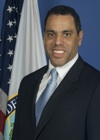Filed Under > TC Community
Upper Manhattan Principals Meet with U.S. Education Official
With all the federal initiatives focusing on education in recent months, Teachers College assembled a group of 150 Upper Manhattan school principals on August 30 to meet with Anthony W. Miller, deputy secretary and chief operating officer of the U.S. Department of Education.
With all the federal initiatives focusing on education in recent months, Teachers College assembled a group of 150 Upper Manhattan school principals on August 30 to meet with Anthony W. Miller, deputy secretary and chief operating officer of the U.S. Department of Education. Following Miller’s comments, President Susan H. Fuhrman moderated a panel discussion with Eric Nadelstern, deputy schools chancellor at the New York City Department of Education; and TC faculty members Luis Huerta, Erica Walker and Douglas Ready. The meeting was cosponsored by Rep. Charles B. Rangel.
At the Faculty House at Columbia University, Miller and Rangel discussed federal policy changes and initiatives, including the $4 billion Race to the Top competition among states. On August 24, New York State was awarded $700 million in Race to the Top funds, of which $250-300 million is slated to go to New York City schools.
In preliminary remarks, Rangel called education a “national security issue,” saying a well educated workforce is critical to maintaining the United States’ leadership in research and development, trade and commerce, and economic strength. He said education schools are the first link in a chain of education reform. “If you teach teachers well, it makes it a lot easier to teach students. The very salvation and survival of our economy now is dependent on it.” He added, “the role that Teachers College plays in education teachers has never been more important.”
Miller detailed the changes the Obama administration has encouraged through the Race to the Top competition, which rewarded states that had made progress on or accomplished four broad goals: high-quality, rigorous standards and assessments; the creation of data systems to track students’ progress; a system to recruit, develop and reward effective teachers; and reforming or closing ineffective schools. Alignment of these goals and practices at the federal, state and local levels has been critical to ensuring that “all American students get the world-class education they deserve.”
In addition to Race to the Top money, Miller said that, fulfilling a campaign promise by President Obama, the Department will award $10 million grants later in September to each of 20 communities to replicate the Harlem Children’s Zone, which has coupled educational programs with other services to children and families, including health care, parenting classes and adult instruction.
The panelists took questions and comments, first from Fuhrman, who noted that although many states have agreed to work together on national standards and assessments, “a lot of components have yet to be developed.” She asked how school districts and the U.S. DOE will evaluate reform measures near-term, if states have not yet agreed on national tests.
Nadelstern said he believed that the DOE has pushed “exactly the right reforms,” including “value-added performance of teachers in like-populated schools”; the ability to capture and use data effectively; a focus on turning around or closing ineffective schools, which, he argued, creates “better options for students and families”; and innovating instructional materials and strategies. He called present-day schools “essentially 19th-century inventions.”
Huerta added that it is very important to consider how much in financial and human resources will be necessary to accomplish the reforms that administrators and policymakers say they want. “There is some very excellent work on costing out the talents and capacity necessary to reach certain ends,” he said.
To a question from the audience about the commitment to maintaining a rounded curriculum, including the arts, Miller responded, “We need to pay attention to what engages students. Sometimes that is art, sometimes physical education.” Federal officials, he said, should make sure that the basics in English language arts, mathematics and science are covered, and leave to local districts the other disciplines that support those three.
Walker, a professor of mathematics education, countered that the federal strategy “won’t do any good if the curriculum does not provide rigorous, rich math content” in all schools. Walker described some students in New York who were petitioning their public high school to institute a calculus course, which was not available to them. “Some opportunities are not even an option in some schools.”
Another questioner asked why federal and local education officials seemed so committed to charter schools as the solution to the ills of public schools, when “the data is mixed coming out of charter schools and most don’t have data of any longevity.” Miller responded, “We’re committed to good charters, not just charters. We’re not trying to ‘charterize’ public education. But to impose an artificial cap on innovation is not the answer.”
One-time infusions of federal education funds flowed generously from Washington in the past year, but in many states, those funds were used to plug holes in already skimpy local and state school budgets. State and local school systems anticipate a “funding cliff” next year when federal grants are not renewed, and many are cutting budgets now in order to prepare. Councilman Robert Jackson, chair of the City Council’s Education Committee, asked how schools expect to close the achievement gap “with continuous budget cutbacks and the state and local level.”
Nadelstern agreed that “more cuts portend a disaster for the New York City public school system.” Fuhrman said the reduced funding requires schools to “drastically improve the productivity of the schools, and that involves technology.”
The nation’s schools face “significant opportunities but significant challenges,” Miller concluded. “It’s going to take innovation, invention and political will. We need to increase the capacity of schools, states, and the federal government to sustain these reforms” by addressing the “funding cliff,” conducting research to find the “evidence-based strategies that are working,” and “build[ing] the overall collective capacity of the system.”
Published Friday, Sep. 10, 2010
